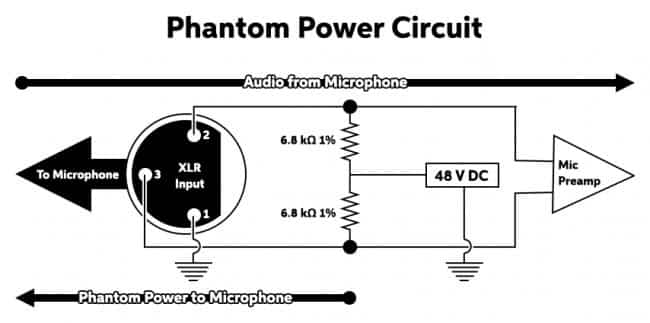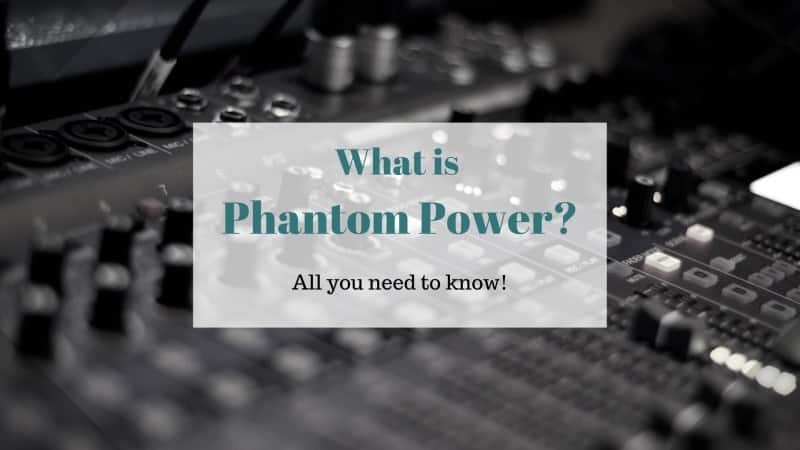Last updated on February 22nd, 2022 at 08:00 pm
The first time I heard the term “Phantom Power” I had no idea what it meant or what it was actually used for.
Back in the day, the producer that I was learning from gave me a very brief explanation which sort-of answered the question, but not really.
This is why I wrote this short post, so you can find out exactly what phantom power is, why it’s needed, if it affects audio quality, and more.
Let’s get straight into it…
What is Phantom Power?
Phantom Power is a method of transmitting DC Voltage (usually 12-48 volts) to power audio equipment via an XLR cable, such as condenser microphones, and it’s called Phantom Power because it doesn’t require an additional cable to power the microphone, since it’s transmitted through the same cable as the Audio Signal.
Phantom Power is more commonly used to power condenser microphones, be it large diaphragm condensers or small diaphragm condensers.
This voltage is used to power the active electronics inside of condenser microphones, such as the diaphragm and the internal power amp, as well as polarizing the transducer element (only on true condensers, not electret).
Dynamic microphones don’t require any additional power, like phantom power, since they can generate enough current on their own to provide a good audio signal.
This voltage is supplied through the microphone cable, specifically through Pin 2 and Pin 3 of a typical balanced XLR cable.

This means that if the supplied power is 48v, like it usually is, then Pin 2 will be 48v, Pin 3 will be 48v and Pin 1 will be the ground.
What does this mean for you?
A condenser microphone, unless it’s a USB microphone or one that uses a battery to generate this voltage, will require some additional equipment to be used, like an Audio Interface, a mixer, a PA system, etc.
Of course, you could also get a phantom power supply, but more on this in a bit.
Why do you need Phantom Power for a Microphone?

Condenser microphones have active electronics in them that need an external power source to be able to record at a usable signal. If you connect a condenser microphone to an Audio Interface but don’t hit the +48v phantom power switch, it may be able to record but at a barely audible- and therefore -usable level.
Essentially, if you’re using a condenser microphone, you absolutely need phantom power.
Do you need Phantom Power for Dynamic Microphones?
No.
Dynamic microphones have a coil in them that is capable of generating a lot more current than the small and light diaphragm in a condenser microphone, and therefore this signal doesn’t need to be amplified as much.
Dynamic microphones still need a decent preamp to increase the gain, but that’s about it.
Is Phantom Power bad for Dynamic Microphones?
Dynamic microphones don’t have active electronics in them which means that they don’t need any additional power to work properly.
In the vast majority of cases, you don’t need to worry about phantom power damaging dynamic microphones since they are designed to accept it without any issues.
However, you should always check the manual or contact the manufacturer to be safe, especially if you have a passive ribbon mic since it could really hurt them.
My recommendation would be to turn it off if you are using a passive dynamic mic, just to be on the safe side.
Why is Phantom Power 48v?
The worldwide standard for phantom power is 11 to 52 volts of DC current and most condenser studio microphones run on 48v, drawing current from this voltage based on their needs.
This is why the standard is 48v, simply because most microphones require it to run properly.
However, some microphones work perfectly at the lower voltage ranges and get no real performance boost at higher voltages.
In fact, they could be categorized like this;
- Microphones that work between the 9 – 48v range without any performance benefit at the higher voltages or any performance loss at the lower voltages.
- Microphones that work between that same 9 – 48v range but that suffer a decreased headroom at the lower voltages.
- Microphones that won’t work at all unless they are powered by 48v phantom power.
Basically, 48v will get every condenser microphone working properly.
Is it safe to connect or disconnect a mic when phantom power is on?
Even though this shouldn’t affect your gear in the short term, if you plug or unplug your mics consistently with phantom power on, you could seriously damage them.
Make sure to ALWAYS turn it off before plugging and un-plugging your mics.
Furthermore, it’s good practice to turn the gain all the way down to zero before plugging or unplugging your mics to protect your monitors from unwanted popping sounds.
Does Phantom Power affect audio quality?
The short answer; it depends.
The long answer is a bit more complex because it all depends on the quality of your gear.
If you’re connecting the mic to your PC using a USB adapter with an XLR to 3.5mm cable, then yes, for the simple fact that these adapters don’t provide the best audio quality.
Additionally, if you try and record audio with a condenser mic without engaging the phantom power, you will be able to but only at a very low level.
This will force you to increase the gain which in turn will lead to higher background noise.
Adding a phantom power supply will boost the signal, allowing you to reduce the gain which will lower the background noise significantly, plus the overall sound quality will increase.
The best solution?
If you want a good long-term solution, then I’d highly recommend investing in an audio interface.
Even the cheapest ones on the market provide phantom power, plus their preamps are quite decent which will make your audio recordings a lot better.
What equipment provides Phantom Power?
Phantom power supplies usually come built-in most audio mixers, preamps and audio interfaces, but you can also get a phantom power supply on its own.
In the vast majority of cases I would recommend simply getting an Audio Interface or a simple Mixer for the same reason I explained earlier…
Phantom Power is very important, but the quality of your preamps also is and if you want to get good sounding recordings, then a good Audio Interface or Mixer should be a priority.
If you’re in need of an audio interface or mixer that can provide phantom power and that comes with great preamps, then check my recommended gear page where you will find two excellent Audio Interfaces and Mixers.
Conclusion
Phantom power is essential if you’re using a condenser mic.
It can increase the audio quality and lower the background noise, depending on the quality of the gear you are using.
I wouldn’t really recommend getting a phantom power supply on its own since you can get a cheap audio interface which will provide phantom power as well and an overall better audio quality.
I hope this information was useful!
Have a great day!

..all the information except how much current can be drawn to power a mike with its internal circuits …
Nice article